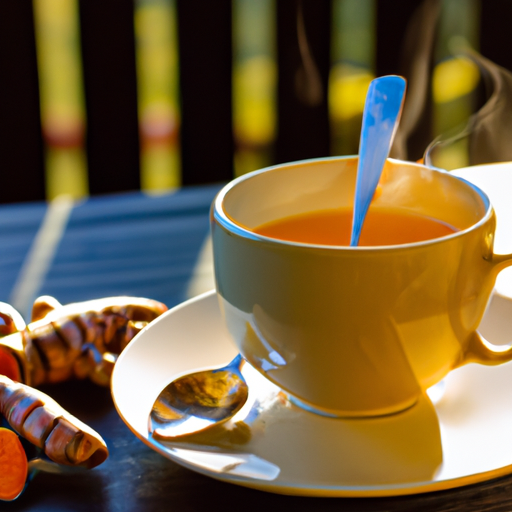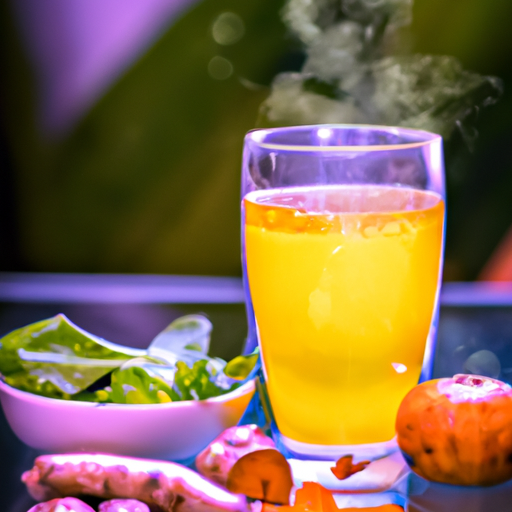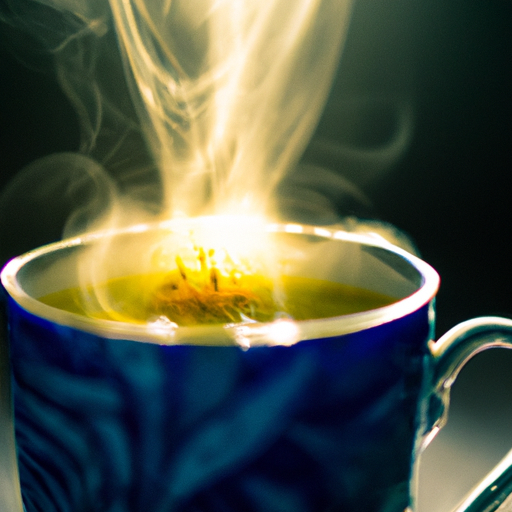Ginger turmeric tea is the perfect remedy for those seeking to enhance their immune system, decrease inflammation, and enhance digestion. Whether you’re feeling unwell or simply in need of a little pick-me-up, this tea is the solution you’ve been looking for! It’s like a comforting embrace in a mug that will make you feel revitalized and refreshed.
Making ginger turmeric tea at home is easy-peasy and requires only a handful of ingredients that you probably already have in your pantry. In this article, I’m going to show you how to make the perfect cup of ginger turmeric tea step-by-step.
So get ready to fall in love with this golden brew and reap all its health benefits while enjoying every sip!
Key Takeaways
- Ginger turmeric tea has numerous health benefits, including boosting immunity, reducing inflammation, improving digestion, and enhancing mood.
- The tea can be easily made at home with a few simple ingredients and should be simmered for 20-30 minutes for maximum flavor extraction.
- The ideal ratio of ginger to turmeric is 2:1 and black pepper can enhance the absorption of curcumin.
- Leftovers should be stored in an airtight container in the refrigerator for up to 3 days and the optimal serving temperature is 160-170°F (71-77°C).
Health Benefits of Ginger Turmeric Tea
You’ll be amazed at how many health benefits you can enjoy just by sipping on a warm cup of ginger turmeric tea! Ginger and turmeric are both known for their anti-inflammatory properties, which can help reduce pain and swelling in the body. They also have antioxidant properties that can protect against free radicals, which contribute to aging and disease.
In addition to its potential health benefits, ginger turmeric tea is also a delicious addition to any meal. It’s often used in cooking as a seasoning or spice, adding depth of flavor to dishes like curries, soups, and stir-fries.
However, it’s important to note that consuming too much ginger or turmeric may cause potential side effects such as upset stomach or diarrhea. So make sure to check with your doctor before adding large amounts of these ingredients into your diet.
With that being said, let’s gather our ingredients and get started on making this tasty and healthy beverage!
Gather Your Ingredients
Once I’ve rounded up all the necessary components, it’s smooth sailing from there.
For ginger turmeric tea, you’ll need fresh ginger root and turmeric root which can be found in most grocery stores or at a local health food store. If you’re unable to find fresh roots, you can also use powdered forms of these ingredients. You’ll also need black pepper, honey or maple syrup for sweetness (optional), and water.
There are many variations of ginger turmeric tea that you can make depending on your taste preferences. For a spicier tea, add more ginger while for a milder flavor, use less. You can also experiment with adding other spices such as cinnamon or cardamom for added flavor and health benefits.
With the ingredients gathered and any desired variations in mind, it’s time to prepare them for brewing your delicious cup of ginger turmeric tea!
Prepare Your Ingredients
To get ready for brewing, start by peeling and slicing the fresh ginger and turmeric roots into small pieces. It’s important to source high-quality ingredients from a reputable supplier to ensure maximum flavor and health benefits. Additionally, there are alternative preparation methods such as grating or using a mortar and pestle to break down the fibers of the roots before brewing.
Once your ginger and turmeric are prepped, it’s time to move on to boiling water. But before we do that, let me emphasize the importance of using filtered water instead of tap water. Tap water can contain chemicals like chlorine that can negatively affect the taste of your tea.
So, grab your favorite kettle or pot and let’s get started on the next step!
Boil Water
So now that I’ve got my ingredients ready, it’s time to boil some water for my ginger turmeric tea.
The first thing I always make sure to do is use filtered water. This ensures that the taste of the tea isn’t affected by any impurities in tap water.
Additionally, I aim for an ideal temperature of around 200°F (93°C) when boiling the water for my tea. This allows the flavors to properly infuse without scorching or burning any of the delicate ingredients.
Filtered water
Filtered water is like a blank canvas for your ginger turmeric tea, providing a pure and untainted base that allows the flavors to truly shine. But it’s not just about taste – using filtered water also has health benefits. By filtering contaminants from water, you can reduce your exposure to harmful substances such as chlorine, lead, and bacteria.
Here are some benefits of filtered water when making ginger turmeric tea:
-
It enhances the flavor profile by removing impurities that can affect taste.
-
It can improve digestion by reducing the amount of chlorine in your system.
-
It can boost immunity by removing harmful bacteria that may be present in tap water.
-
It promotes overall health by reducing your exposure to potentially harmful contaminants.
Now that we have our purified water ready, the next step is to heat it up to the ideal temperature for brewing our tea.
Ideal temperature
You’ll want to ensure that the water for your delicious ginger turmeric tea is heated to the ideal temperature, as this plays a crucial role in bringing out all the flavors and health benefits of your tea.
Regulating temperature is one of the key tea brewing techniques, and getting it right can make a significant difference in the final product. The ideal temperature for steeping ginger turmeric tea is between 205°F (96°C) and 212°F (100°C).
However, boiling water can be too harsh on some teas and herbs, so it’s best to heat the water until bubbles start forming at the bottom of your pot or kettle but before it comes to a full boil. This ensures that you achieve optimal extraction without damaging any delicate ingredients.
Now that you’ve got your water sorted, let’s move on to adding ingredients!
Add Ingredients to Water
Now that I’ve got my water boiling, it’s time to add the ingredients for my ginger turmeric tea. The ratio of ginger to turmeric is important for both flavor and health benefits. I usually aim for a 2:1 ratio of ginger to turmeric.
Additionally, adding a pinch of black pepper can enhance the absorption of curcumin, the active ingredient in turmeric.
Ratio of ingredients
To make a delicious cup of ginger turmeric tea, all you need is a 2:1 ratio of fresh grated ginger to ground turmeric. This ingredient measurement will ensure that the tea has just the right balance of spicy and earthy flavors. Keep in mind that this ratio can be adjusted based on personal preference, but it is important to maintain the 2:1 proportion.
For reference, here is a table outlining different ratios for different flavor variations:
| Ginger | Turmeric |
|---|---|
| 2 | 1 |
| 3 | 1 |
| 4 | 1 |
Now that we have determined the proper ratio for our tea, we can move on to adding black pepper.
Adding black pepper
Adding black pepper enhances the flavor and nutritional benefits of your ginger turmeric brew. Black pepper contains a compound called piperine, which has been shown to increase the absorption of curcumin (the active ingredient in turmeric) by up to 2000%. This means that when you add black pepper to your tea, you are increasing the amount of curcumin that your body can absorb and utilize.
But black pepper isn’t the only spice you can add to your ginger turmeric tea. There are many alternative spices that also have health benefits and can enhance the flavor of your brew. Cinnamon, for example, is a warming spice that can help regulate blood sugar levels. Cardamom is another option – it’s known for its digestive benefits and adds a slightly sweet and floral note to your tea. Experiment with different spices until you find a combination that works best for you.
Now that we’ve added our preferred spices, it’s time to simmer the mixture on low heat for about 10 minutes before straining out any solids.
Simmer Mixture
Now that we’ve added our ingredients to the water, it’s time to let them simmer.
The ideal simmer time for this ginger turmeric tea is around 20-30 minutes.
During this time, I like to stir the mixture occasionally to ensure all the flavors are evenly distributed.
So, let’s turn down the heat and let it gently simmer away while we prepare our cups.
Ideal simmer time
As the ginger and turmeric steep in the water, their flavors intensify with each passing minute until the ideal simmer time is reached. Simmering is an important step in making ginger turmeric tea as it allows for the extraction of flavor from these two key ingredients. By simmering, we are able to release their essential oils into the water, giving us a potent and flavorful brew.
To achieve the perfect simmer time, it’s best to let your mixture bubble gently for at least 10 minutes but no longer than 20 minutes. This sweet spot allows for maximum flavor extraction without overdoing it and turning your tea bitter or too spicy. To ensure that you’re getting the most out of your ginger turmeric tea, I recommend using a timer to keep track of your simmer time.
Now that we’ve achieved our ideal simmer time, it’s time to move on to stirring occasionally while continuing to let our mixture steep. This will help distribute all of those delicious flavors evenly throughout our tea so that every sip is equally delicious.
Stirring occasionally
To enhance the flavor of your brew, don’t forget to give it a gentle stir every now and then while allowing it to steep. Stirring techniques are crucial when making ginger turmeric tea because they help distribute all the flavors evenly in the mixture.
Stirring occasionally also prevents those ingredients from settling at the bottom, ensuring that you get a consistent taste with every sip. When stirring, make sure to use a wooden spoon or any non-reactive utensil that won’t affect the delicate flavors of your tea.
You can stir once every few minutes or whenever you feel like giving it a quick mix. The goal is to keep everything moving and prevent any clumping or sticking as much as possible. By doing so, you’ll achieve a more balanced flavor profile and enjoy all the health benefits of ginger turmeric tea.
Now let’s move on to straining our mixture for an even smoother cup!
Strain Mixture
Once the ginger and turmeric have simmered for 10 minutes, it’s time to strain the mixture.
There are various straining techniques that you can use depending on what tools you have at home.
If you have a tea infuser, simply pour the mixture through it into a teapot or mug. This will catch any large pieces of ginger or turmeric, leaving behind a smooth and fragrant tea.
If you don’t have a tea infuser, you can use a fine mesh sieve or cheesecloth instead. Place either option over your desired container and slowly pour the mixture through it.
The fine mesh sieve will catch most of the pieces while cheesecloth may require more effort as it needs to be squeezed to extract all of the liquid from the pulp.
Once strained, discard the pulp and enjoy your freshly brewed ginger turmeric tea!
To add honey or lemon (optional), simply stir in your desired amount after straining while still hot. Honey adds sweetness while lemon gives it an extra zingy kick that complements its earthy taste perfectly.
Add Honey or Lemon (Optional)
Now that I’ve brewed my ginger turmeric tea, it’s time to add some honey or lemon for a touch of sweetness. Not only do these additions enhance the flavor of the tea, but they also come with their own unique health benefits.
Personally, I prefer to add a dollop of honey as it has antibacterial properties and can soothe a sore throat. However, if you’re looking for a tangy twist, lemon is rich in Vitamin C and can aid digestion.
Health benefits
You’ll be amazed at the health benefits of ginger turmeric tea, from reducing inflammation to boosting your immune system. This tea is packed with nutritional properties that make it a wonderful addition to your daily routine.
Here are just a few of the benefits you can expect:
-
Anti-inflammatory: Ginger and turmeric both contain compounds that have been shown to reduce inflammation in the body. This can help alleviate symptoms of conditions like arthritis and asthma.
-
Immune-boosting: Both ginger and turmeric have antimicrobial properties that can help fight off infections. They also contain antioxidants that protect against free radicals, which can damage cells and contribute to chronic disease.
-
Digestive aid: Ginger has long been used as a natural remedy for digestive issues like nausea and bloating. Turmeric may also help improve digestion by increasing bile production in the liver.
-
Mood enhancer: Some studies suggest that both ginger and turmeric may have mood-enhancing effects, potentially helping to ease symptoms of depression or anxiety.
With all these amazing health benefits, there’s no reason not to try adding ginger turmeric tea into your daily routine! And if you’re worried about the taste, don’t worry – we’ll discuss flavor preferences next.
Flavor preferences
Flavor preferences play a pivotal role in determining the taste of ginger turmeric tea, and they can vary from person to person. While some prefer a strong ginger flavor, others may enjoy a more subtle taste with added sweetness. It’s important to note that the recipe variations for this tea are endless, as there are many ways to adjust the flavor profile based on individual preferences.
To give you an idea of how different ingredients can impact the taste of your tea, I’ve created a table below that outlines three common variations of ginger turmeric tea. As you can see, each recipe uses slightly different amounts and types of ingredients which will result in varying flavors.
| Recipe | Ginger (sliced) | Turmeric (powder) | Honey |
|---|---|---|---|
| A | 2 inches | 1 tsp | 1 tbsp |
| B | 3 inches | 1/2 tsp | 2 tbsp |
| C | 1 inch | 2 tsp | None |
With these recipe variations in mind, feel free to experiment and find what works best for your individual taste preferences. Once you’ve brewed yourself a delicious cup, it’s time to serve and enjoy!
Serve and Enjoy
Now that my ginger turmeric tea is ready, I can’t wait to indulge in its warm and comforting flavors.
The ideal serving temperature for this tea is hot, but not scalding, so I’ll let it cool down just a bit before sipping.
As for pairing with snacks or meals, this tea goes well with light and savory dishes like salads or sandwiches.
Ideal serving temperature
Ideally, this tea should be served at a temperature that allows the flavors of ginger and turmeric to fully develop. The optimal serving temperature for ginger turmeric tea is around 160-170°F (71-77°C). This temperature range not only enhances the taste but also ensures that the tea’s nutrients are preserved.
To achieve this ideal temperature, it is recommended to use a thermometer or an electric kettle with a temperature setting. Steeping time and water temperature variations can affect the flavor profile of the tea. If steeped for too long or at too high a temperature, the tea may become bitter and overpowering. Conversely, if steeped for too short or at too low a temperature, it may lack depth and complexity. Therefore, it is essential to find your preferred balance between steeping time and water temperature to obtain the perfect cup of ginger turmeric tea.
When serving this delicious beverage, you can pair it with snacks or meals that complement its unique flavor profile. Let’s explore some ideas in our next section on how to elevate your drinking experience!
Pairing with snacks or meals
To really take your drinking experience up a notch, why not pair this delicious warm beverage with some sweet or savory treats that complement its unique taste profile? You’ll feel like you’re indulging in a delightful symphony of flavors and textures!
Ginger turmeric tea pairs well with a variety of snacks and meals, making it the perfect addition to your daily routine. For a quick snack, try pairing ginger turmeric tea with some fresh fruit such as sliced apples or berries. The sweetness of the fruit will balance out the spiciness of the tea, creating a refreshing combination.
Another great option is to pair the tea with nuts or seeds for added crunch and protein. Almonds, walnuts, and pumpkin seeds are all good choices that provide essential nutrients and healthy fats. If you’re looking for something more substantial, consider serving ginger turmeric tea alongside a bowl of soup or salad. The warmth of the tea will complement these dishes nicely and make for a satisfying meal.
Now that you have some ideas on how to pair your ginger turmeric tea with snacks and meals, you may be wondering what to do with any leftovers. Don’t worry – storing leftover ginger turmeric tea is easy! Simply pour any remaining liquid into an airtight container and store it in the refrigerator for up to three days. When ready to enjoy again, simply reheat on the stovetop or in the microwave and serve hot.
Storing Leftovers
When you’re done enjoying your delicious ginger turmeric tea, don’t forget to store any leftovers properly so you can enjoy it later without compromising its flavor and health benefits. One of the best storing tips for ginger turmeric tea is to let it cool down completely before storing it in an airtight container. This prevents condensation from forming inside the container, which can lead to mold growth and spoilage.
Another important factor to consider when storing ginger turmeric tea is its shelf life. Generally, freshly brewed ginger turmeric tea should be consumed within 2-3 days if stored in the refrigerator. Beyond that time frame, the flavor may start to deteriorate and some of its health benefits may diminish. To help keep track of how long your ginger turmeric tea has been stored, use this simple table as a guide:
| Storage Time | Flavor and Health Benefits |
|---|---|
| 1-2 days | Optimal |
| 3-4 days | Good |
| 5 or more days | May start to deteriorate |
By following these simple storing tips and keeping track of the shelf life of your ginger turmeric tea, you can ensure that each cup is just as flavorful and beneficial as the first. So go ahead, brew up a batch and save some for later – your taste buds (and body) will thank you!
Frequently Asked Questions
How much ginger and turmeric should be used to make the tea?
I once made ginger turmeric tea with too much ginger and it was overpowering. For a balanced flavor, I recommend using 1-2 teaspoons of grated ginger and 1 teaspoon of turmeric per cup of water. Add honey to taste.
Can the tea be made with ground ginger and turmeric instead of fresh?
Ground ginger and turmeric can be used to make tea, but fresh ingredients are more potent in terms of health benefits. The ground vs. fresh debate is ongoing, with some claiming that powdered versions may lose potency over time.
Is it safe to consume ginger turmeric tea on a daily basis?
As a daily drinker of ginger turmeric tea, I’ve experienced its health benefits firsthand. Studies suggest it may reduce inflammation and improve brain function. However, excessive consumption can lead to digestive issues and interact with certain medications.
Can the tea be made in advance and stored for later consumption?
Storing tea is like keeping a treasure for later enjoyment. To maintain its flavor and aroma, I suggest using airtight containers and storing in a cool, dark place. Experiment with different brewing techniques to find your preference.
How long should the tea be simmered for optimal flavor and health benefits?
For optimal flavor and health benefits, I recommend simmering the tea for 10-15 minutes. This allows for a strong infusion of the ginger and turmeric, which are known for their anti-inflammatory properties.
Conclusion
Overall, making ginger turmeric tea is a simple and delicious way to reap the numerous health benefits of both ginger and turmeric. But beyond just tasting good, research has shown that these two ingredients may actually have powerful medicinal properties.
Studies have found that the active compounds in ginger and turmeric can help reduce inflammation, improve brain function, lower cholesterol levels, and even potentially fight against certain types of cancer. While more research is needed to fully understand their effects on human health, incorporating ginger and turmeric into your diet through things like tea is an easy step you can take towards better wellness.
So why not give it a try? Your taste buds (and body) might thank you!










